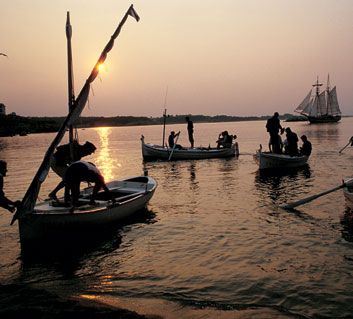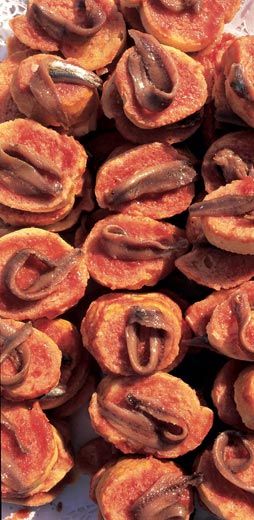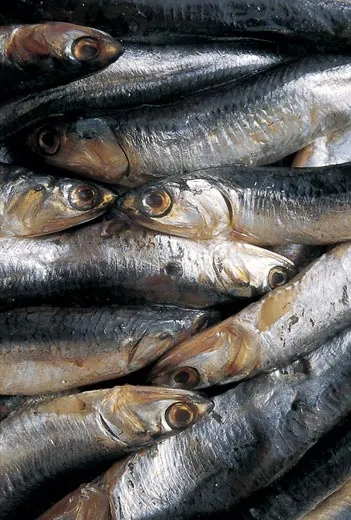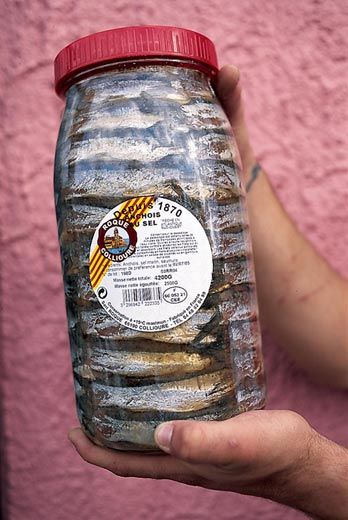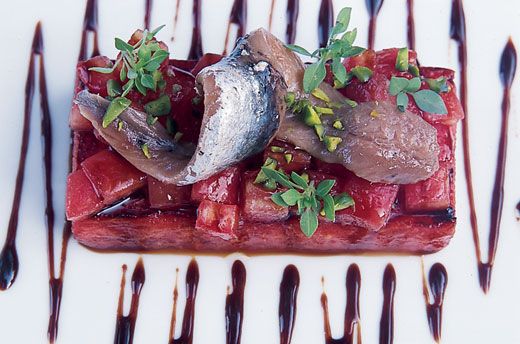Homage to the Anchovy Coast
You may not want them on your pizza, but along the Mediterranean they’re a prized delicacy and a cultural treasure
Joan Carles Ninou smiles broadly and laughs easily, signs of a man who can appreciate life’s jollier moments. But get him talking about anchovies and you’ll soon realize that a serious streak runs through him, a streak as deep as the Mediterranean Sea that washes the coves and craggy headlands of his native Catalonia.
Aboisterous lunchtime crowd fills El Xampanyet, Ninou’s storefront café tucked away in the cobblestone labyrinth of Barcelona’s Ribera Quarter. As he pours wine or rings up a bill, Ninou chats in Catalan with a lively mix of blue-collar and office workers seated at small tables or bunched along a marble bar covered with platters of bright red marinated peppers, herb-flecked olives and other tapas. An animated man with hair cropped so close it looks like a shadow on his shiny, round head, Ninou also has two of the most expressive eyebrows I’ve ever encountered, a matched pair of fuzzy, black caterpillars whose rise and fall mark the tempo of his conversation. And when the topic turns to anchovies, as it inevitably does at El Xampanyet, the eyebrows shift into double time.
“The ancient Greeks brought the art of salting fish to Catalonia,” Ninou says. “And almost since that time, anchovies have been a part of our life here.”
El Xampanyet doesn’t go back quite as far as Aristotle— only to 1929, when Ninou’s grandfather opened the place— but house-cured anchovies have been its specialty for decades. From my perch next to the tapas, I watch as a barman vigorously rinses five-inch-long anchovy fillets in fresh, running water to remove any excess salt. Across the room I spot a customer in blue coveralls drinking beer and downing the little fish like a trained seal: picking each one up by its tail, tilting his head back and lowering it into his mouth. I try a few myself, seal-style, and discover that with their ruddy brown color, firm texture and rich, meaty taste, they bear no resemblance whatsoever to the mushy, gray slivers of sharp fish-salt flavor that pass for anchovies in most of the world. Locals will tell you that what makes a Catalan anchovy special is the traditional way in which it’s cured, and Ninou’s may be the best anchovies in all of els països Catalans—the Catalan lands. Unless, perhaps, you count those I tasted the day before at La Boqueria, Barcelona’s vast and bustling covered market. Or those from the Costa Brava towns of l’Escala and Cadaqués, or from the port of Collioure, across the border in France, renowned for the artisanal salt-curing of anchovies since medieval times.
You won’t find the words “Costa de l’Anxova” on any map, but that doesn’t mean it’s not a real place. Catalan for Anchovy Coast, the name aptly describes a roughly 50-mile stretch of Mediterranean shore that lies mostly in Catalonia, the northeasternmost region of Spain, but that also spills over into southwestern France, where residents retain cultural and linguistic ties with their Catalan neighbors. Though each country has nicknamed its coast—Costa Brava, or WildCoast, in Spain, and Côte Vermeille, or VermilionCoast, in France—in truth the region is neither exclusively Spanish nor French. Arocky, sunbaked land whose picturesque ports and lapis waters have captivated landscape painters for a century, it remains proudly Catalan in tradition, especially on the Spanish side of the border. And this includes not only a fierce devotion to the Catalan tongue, a Romance language that’s been around for a thousand years, but also an abiding love for the humble anchovy.
For Americans accustomed to anchovies as a salty jolt to Caesar salad or pizza—or, more commonly perhaps, as something to be avoided at all costs—the Catalan treatment of the fish, both fresh and preserved, is a revelation. Though it also figures in many other Mediterranean cuisines, along the Anchovy Coast it assumes dozens of fetching guises—from traditional preparations like boquerónes (pickled fresh anchovies), anchovy-chard fritters, puff pastry with anchovy butter, and an anchovy and pine nut topping for the pizza-like coca, to more recent creations like an hors d’oeuvre of deep-fried anchovy bones, a bright-tasting tartare of seitó (the Catalan name for the fresh anchovy) and a sauté of anchovies and apples that reflects the Catalan taste for sweet-and-salty dishes. What’s more, for some Catalans, the anchovy assumes near-Proustian significance. The great 20th-century Catalan author Josep Pla wrote—with tongue only partly in cheek—that you’ll remember the anchovies of l’Escala for quite a while, though not forever, since in time you might confuse them with your first love.
“The anchovy is a quintessential Catalan product with a long tradition,” says internationally acclaimed chef Ferran Adrià, who has managed to stretch that tradition at El Bullí, his restaurant in the Costa Brava town of Rosas, with dishes like anchovy-topped grilled watermelon and anchovy gelato. I’ve met Adrià at the annual anchovy and salt festival in l’Escala, where he has come to receive the town’s Golden Anchovy award for promoting its flagship product. A pale, thoughtful man with profoundly brown eyes, he recalls how, as a child, his mother used to salt anchovies each summer at their home on the outskirts of Barcelona. But Adrià’s fond memories are shadowed by worry. He tells the fishermen, salters and other townsfolk assembled at city hall that Catalan anchovies are being threatened as never before, and he names a twin menace—a diminished Mediterranean catch and the onslaught of fast-food culture. “If we’re not careful,” he warns, “in five years our tradition may be lost.”
Because most of the world’s hundred-plus species are easily damaged when caught with a net, the only anchovy you’re likely to find in a restaurant or on store shelves is the hardy Engraulis encrasicolus, commonly known as the European anchovy. A slender, silvery blue-green creature with a pointy snout and forked tail, it can grow nearly eight inches long in its three-year life, though often it’s caught before reaching that size. The small fish has an unusually large jaw— hence one of its Spanish names, boquerón, or “big mouth.”
Found in coastal waters of the eastern Atlantic from Norway to South Africa, as well as in the Mediterranean, Black and Azov seas, European anchovies swim in compact schools and feed on plankton and other nutrients during the day, dispersing into shallower waters at night. They love a full moon and traditionally are fished using a light known as a lamparo. Suspended from the prow of a small boat floating within the perimeter of a purse seine net, the light mimics the moon and lures the fish to the surface.
The anchovy has been fished and preserved along the Mediterranean for millennia. In the bestselling Salt: A World History, author Mark Kurlansky writes that of all the region’s salted fish—which historically have included tuna, sardines, herring and eel—anchovies have been the most highly praised since the time of the Greeks, who took salted fish so seriously they dreamed up words to describe the type of cure, the origin of the fish and whether it was salted with or without scales. Anchovies often went into garum, the pungent fermented fish sauce favored by Roman empirebuilders— and alternately described in contemporary accounts as heavenly or putrid—and fish from Catalonia were thought to make a superior version.
The extensive Greco-Roman ruins of Empúries, a deserted complex of stone walls, mosaic fragments and temple columns just outside l’Escala, bear witness to the ancient origins of the Catalan anchovy. One of the most important archaeological sites in Catalonia, Empúries was the point of entry to the Iberian Peninsula for Greek, and then Roman, culture, including Greek techniques for preserving fish with salt. From Empúries, the knowledge traveled to Naples and Sicily, which eventually became important fish-salting centers.
Visiting the once-thriving commercial port on a bright October afternoon, just after a ferocious storm had lashed it with rain and sent huge waves crashing into a 2,000-year-old stone jetty, I came across the excavations of a first-century workshop specializing in fish preserves and sauces. Time and the elements have reduced it to low walls of dry masonry, but I could pick out the central patio where fish were cleaned, and rooms where they were salted and stored in jars. Long after most of Empúries was abandoned in the third century, the workshop techniques continued to be used by successive generations of local fishermen, who in the 16th century founded l’Escala and its anchovy factories. By the 18th century, salted anchovies had brought l’Escala such prosperity that a visitor would make the observation—truly remarkable, for a Mediterranean fishing village of the time—that “men earn good wages, and there are no poor people.”
During the Middle Ages, when salted anchovies were largely a food of the poor, communities all around the Mediterranean produced them, especially in places with ready access to salt. The most famous medieval center of anchovy production was Collioure, where the salting of fish achieved such commercial importance that in 1466 King Louis XI of France exempted the town from the hated gabelle, or salt tax. Well into the 20th century, Collioure was home to dozens of salting houses and a fleet of small, wooden fishing boats called catalans, whose triangular, lateen sails and bright, primary colors attracted Fauvist painters such as Matisse, Derain and Dufy.
After World War II, however, the catalans were supplanted by larger, steel-hulled vessels known as tranynas, which were based in neighboring Port Vendres because they couldn’t navigate Collioure’s shallow harbor, and the number of salting firms in Collioure declined, from 22 in 1945 to only 2 today. In the town of stone houses and narrow lanes wedged between mountains and the sea, under a sky Matisse called the bluest in all of France, locals now cast for tourists, not fish. But as I learned at the small, modern factory of the Roque company, the care that goes into making a salted anchovy here has not changed in any appreciable way.
From May to October, the anchovy season, fresh fish are rushed to the factory and given an initial salting. In an ageold process, quick-fingered women then gut and behead each anchovy with a single flick of the wrist, and in large barrels carefully alternate layers of fish and sea salt from Aigues- Mortes, in the Rhone delta. Heavy weights keep the fish compressed in the brine that soon develops as salt leaches liquid from the anchovies, penetrates their flesh and, in a simple but impressive feat of biochemical legerdemain, slowly transforms them into a preserved product. Exuding a smell reminiscent of an estuary at low tide, the barrels are kept in cool rooms while the anchovies ripen for three months or more—depending on their size, when they were caught, and the ambient temperature. Only the master salter decides when they are ready.
“Anchovies are like fruit,” says Guy Roque, whose 42-employee salting firm was founded by his grandfather in 1870. “If they’re not ripe, they don’t have as much flavor. And for an anchovy to be ripe, it should have a rich aroma and a rosy color.” Fish destined for oil-packed fillets are gently washed in fresh water and manually deboned; a skilled worker can finesse the bones from more than two pounds of anchovies per day. The fillets are laid out to dry overnight and handpacked in retail-size glass jars or commercial-size plastic tubs, which are then filled with sunflower oil. “Sunflower oil is milder than olive oil,” says Roque, “and allows more anchovy flavor to come through.” In a traditional preparation seldom sold in the United States, some fish are left whole and packed in salt. Though this means rinsing and filleting them in the kitchen, many Catalan cooks swear they are actually less salty than their oil-packed counterparts.
Master Chef Ferran Adrià is not the only one who thinks these are tough times for Catalan anchovies. For years, the region’s small salting houses have been forced to compete against large factories and their economies of scale. For example, though the anchovy industry in the Cantabria region, on northern Spain’s Atlantic coast, dates only to the arrival of Sicilian salters in the 19th century, its production dwarfs that of Catalonia. Morocco now leads the world in canned anchovies, and one Moroccan factory—the biggest anchovysalting facility on earth—employs 1,400 people. Catalan traditionalists blame the poor quality of the anchovies most of us eat on methods applied elsewhere to keep costs down—using smaller and less fresh fish, curing them faster, and drying the fillets in centrifuges. And the oldtimers also fret about a fall in anchovy consumption among younger Catalans. “It’s the same the world over,” laments Francesc Moner, a cigar-chomping anchovy company owner in l’Escala. “Traditional foods are getting left behind by the young for hamburgers and other fast food.”
But the declining catch in the Mediterranean remains more troubling than either cheap competition or the popularity of fast food. The sea is far less rich in animal life than the Atlantic, and though European anchovies have never been listed as endangered or threatened, throughout history those from the Mediterranean have been subject to periodic shortages. Unusually hot summer weather, causing sea temperatures to rise beyond the 54 to 68 degrees Fahrenheit range preferred by anchovies, is sometimes the culprit. But overall catch levels have fallen in the past decade regardless of fluctuations in weather, leading industry experts to worry that the recent downturn is more than just a natural, cyclical phenomenon. They point a finger at fishing practices. For the past 20 years, jumbo-size, highly mechanized ships based in France have roamed the sea throughout the year, scooping up fish in huge dragnets. “The nets are much finer than what we use on a tranyna,” says Josep Lluis Sureda, a fourth-generation l’Escala fisherman. “All year long they catch everything in their path, even anchovies that are too small for the salters.”
In fact, the off-season harvest of juvenile fish by either large ship or tranyna, is the greatest threat to anchovies in the Mediterranean, because it removes fish from the sea before they have a chance to breed. In response, the regional government of Catalonia has closed its waters entirely to anchovy fishing from October to December, part of the traditional off-season, to give the anchovy stock time to replenish itself between harvests.
Still, the catch along the Anchovy Coast the past two years fell so short that fish had to be trucked in for salting from French Atlantic ports and from Cantabria, and even Joan Carles Ninou is using Cantabrian fish in his Barcelona café. Catalan salters put a brave face on the crisis—repeating over and over that what truly makes an anchovy a Catalan anchovy is the traditional manner in which it’s prepared. But in the next breath they bemoan the lack of Mediterranean fish, which they find more flavorful than those from colder Atlantic waters.
If the problem of declining catches can be solved, Catalan salters remain hopeful that their anchovy industry will yet survive. There are some signs their optimism may not be misplaced: l’Escala and Collioure have both received legal originof- product denominations—akin to the Roquefort name on cheese or the appellation of a wine—so consumers will know when they’re buying anchovies certified as having been cured in the two towns. Perhaps, local boosters say, the official labeling will help differentiate their plump, rosy fish from cheaper ones with less flavor prepared elsewhere, and will carve a small niche in the lucrative market for gourmet goods. Younger chefs in both Spain and France are dreaming up new ways to use this ancient product, and big names like Ferran Adrià have stepped up to help with marketing it.
For Robert Desclaux, owner of a 102-year-old Collioure salting house, any effort on behalf of the local anchovy is worth it. At age 77, Desclaux is old enough to remember the graceful catalans gliding by night out of the harbor, past the town’s signature bell tower, and the wicker baskets brimming with anchovies being sold on the beach after the boats returned in the morning. “Those times are gone,” he says matter- of-factly. “But with work and some luck, I think our anchovies will survive.” You don’t have to love the little salted fish to hope he’s right.
